11+ Sample Construction Completion Report
-
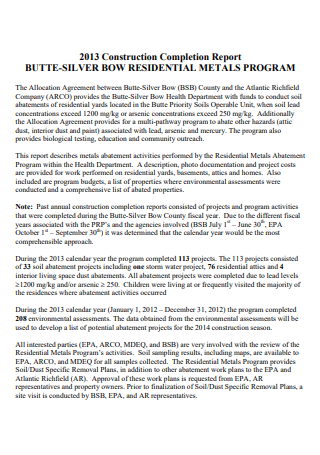
Construction Completion Report Template
download now -
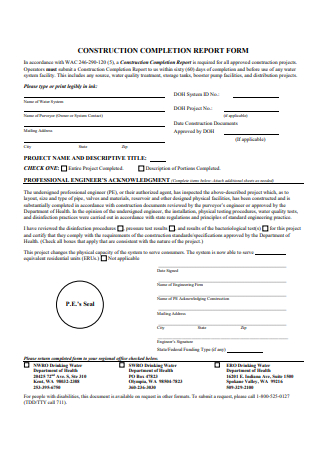
Construction Completion Report Form
download now -
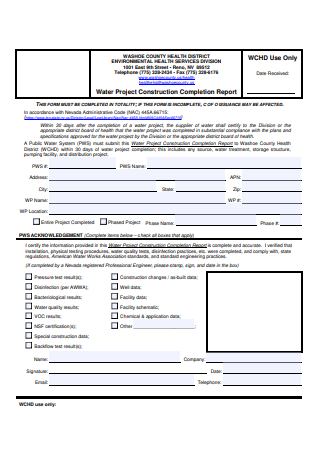
Water Project Construction Completion Report
download now -

Construction Completion Report in PDF
download now -
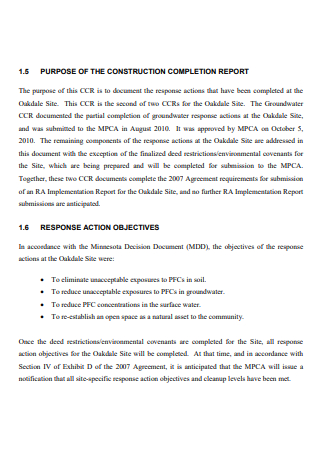
Basic Construction Completion Report
download now -
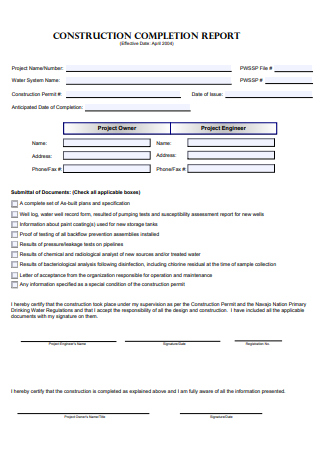
Formal Construction Completion Report
download now -
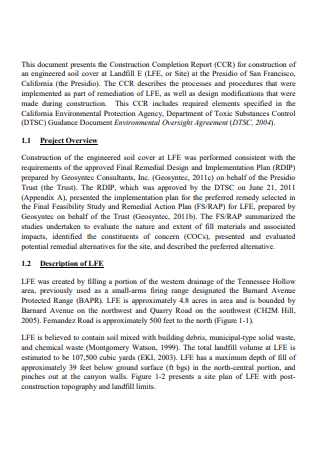
Standard Construction Completion Report
download now -
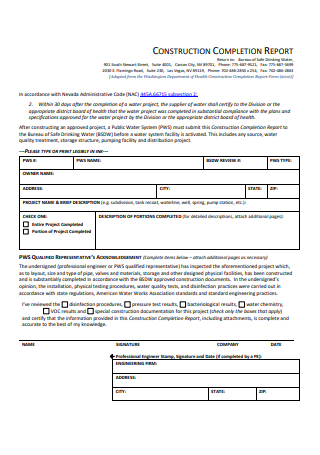
Sample Construction Completion Report
download now -
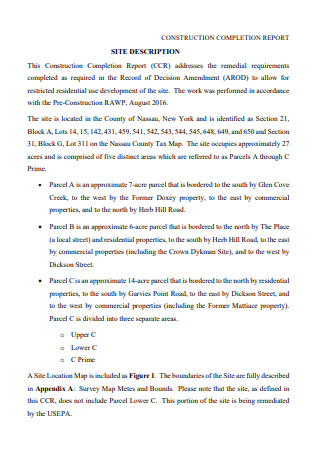
Site Construction Completion Report
download now -
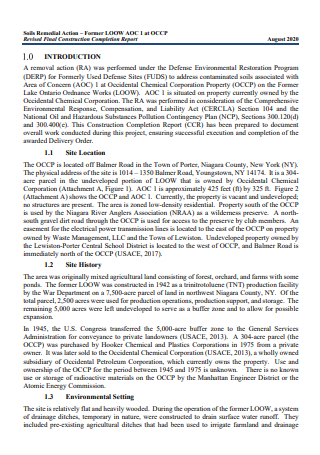
Final Construction Completion Report
download now -
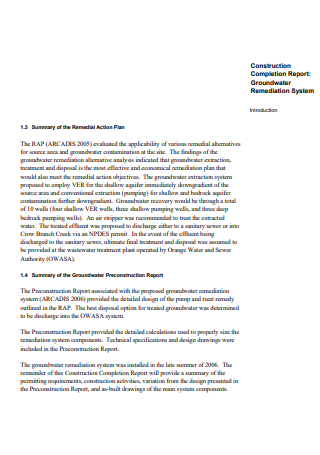
Groundwater Construction Completion Report
download now -
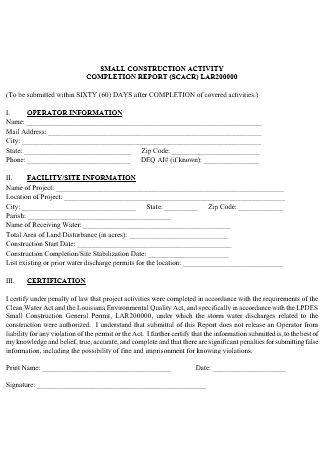
Small Construction Activity Completion Report
download now
FREE Construction Completion Report s to Download
11+ Sample Construction Completion Report
What Is a Construction Completion Report?
Benefits of Construction Reports
Tips for Writing a Project Closure Report
How to Achieve a Construction Project
FAQs
What is the report format?
What is a formal report example?
What is a construction report?
What Is a Construction Completion Report?
A construction completion report is an official record of the conclusion of a construction project. The completion report is of utmost importance since, in the construction sector, it informs the client, local government, and purchaser of significant events, project phases, or processes. It must be well-prepared and preserved even after the acceptance of the completion report. Statistics indicate that 30 percent of construction enterprises fail within the first five years of operation. The primary causes of project failure include ineffective project management, cost overruns, and missed deadlines.
Benefits of Construction Reports
Daily construction reports are also known as site diaries, site journals, site records, and construction logs. So, what is a daily report on construction? They are construction project documentation for all on-site actions and events, including progress made, job timelines, materials, the number of materials, work quality, delays or nonconformances, etc. They contain essential details such as contact information, jobs and responsibilities, dates, places, weather, and the current time. Providing information on construction-related events serves as evidence of completed or missed work. A record of daily events, issues, and remedies are essential for effective project management. They are utilized for post-project debriefing, productivity management, and conflict resolution. Because of this, site diaries must be updated when incidents occur and will become the site manager’s official document or initial record for contact information, scheduling, snagging, meetings, inventory, field notes, accountability, and incident descriptions.
Tips for Writing a Project Closure Report
Regardless of its complexity, every project will eventually end its lifecycle. Also, it is one of the most crucial documents that must be produced upon the completion of a project. It is the final record generated following the conclusion of a project. The report describes every aspect of the project and is frequently utilized by numerous stakeholders to evaluate its performance. In addition to delivering an evaluation of the project’s performance, this document is a valuable resource for identifying best practices to ensure that future initiatives go smoothly. Writing a project closure report is more complex than it initially appears. There are essential steps to take. The phases pertain to a specific portion of the project and must be followed precisely for the desired outcome. These procedures will assist you in writing your project closure report.
1. Provide an Overview of the Project, Including a Summary Statement
The first stage in drafting this project closure document is to provide a basic overview and summary statement of the entire project. A summary statement is a concise explanation of the project’s purpose. It examines the “what” aspect of a project. It looks at what was required to be completed during the project and how it was accomplished. Also, the summary statement of the project in a Project Closure report will provide an overview of the report’s contents. The primary distinction between the project overview and the summary statement is essential. The overview describes the project, scope, and completed activities, whereas the summary statement describes the report and contents.
2. Describe the Project’s Results and Outcomes
Before beginning your project, you documented your key performance indicators and objectives. In addition to key performance indicators, you likely also had outcome targets. This section examines the entire project regarding the key performance Indicators you would have established and the resulting consequences. What are the outcomes of the project? Project outcomes refer to the level of execution or accomplishment that would have occurred due to the project teams’ efforts. However, accurately quantifying project outcomes is not a simple task. Three indicators can determine your project’s favorable or harmful results. The metrics include stakeholder satisfaction, project cost, and overall quality.
3. Describe the Scope, Schedule, and Cost of the Project
This stage is closely related to the preceding but stands on its own about the project closure report. The project scope is the section of a project in which the particular objectives, deliverables, features, timeframes, and tasks are documented. It examines everything required to see a project through from start to finish. This section of the Project Closure Report will discuss the Project’s overall scope, the actual project timeline, and cost. When doing an initial Scope analysis, all aspects, including project costs, are considered. However, these figures can fluctuate and change as the Project progresses, so it’s crucial to compare the actual costs to the estimated prices to determine whether you went over or under budget.
4. Project Performance Analysis
The project performance analysis is arguably the most crucial component of the project closure report. The performance analysis expands on step 3 and compares the actual expenses and schedule of the project to the baseline budget and schedule. For the performance analysis to be practical, it must be broken into three sections: Goals and Objective Performance, Success Criteria Performance, and Schedule and Budget Performance. Underperformance analysis will require you to evaluate your Schedule and Budget Performance. In your project’s Scope, what were the established due dates? Did you meet those deadlines? If not, what were the primary reasons for missing the deadlines? The same questions apply when examining your budget. Where do you need to return to the bank or client for further funding? In any event, studying and comparing your actual performance to your established goals is essential.
5. Project Highlights
The project highlights section examines the project’s highlights throughout its entire duration. It often consists of high-level project information, such as requests and other concerns that developed during the project. It should not be difficult to compile and include the highlight report in the project closure report. Throughout a project, it is advised that you provide at least a summary report after each week to update the various stakeholders on the project’s current status. If you have these reports, you can refer to them and select the main points from each weekly report to include in your final Project Closure Report.
6. Describe and Outline the Obstacles and Dangers Encountered
Every project has its own set of hindrances and risks. This area will allow you to describe any obstacles that may have arisen during the project. Challenges, particularly those associated with projects and management, can be difficult to anticipate. Aside from that, no matter how meticulously you prepare at the outset of the project, you cannot expect every potential obstacle. For future reference and presentation to stakeholders, you should utilize this section to describe every obstacle you encountered throughout the project’s duration. In addition to describing the challenges, you should explain how they influenced other parts of the project, such as the budget and timeline. In addition to highlighting the obstacles, you should also emphasize the hazards. Risks can include the weather, job security, and even money.
7. Describe the Lessons Learned Throughout the Implementation
Challenges are a source of practical learning for any undertaking. You will learn one or two things when you conquer the obstacles encountered during a process. Use this portion of the Project Closure Report to emphasize what you have learned. Throughout the project, you will also collaborate with stakeholders from other industries. Sometimes these stakeholders can teach you critical ways to quickly complete a job. If you learned these strategies from the many project stakeholders you worked with throughout the project’s implementation, you should emphasize them in this area. It is vital to record the lessons learned in this project closure document so that you can always refer to the report of your last project to identify common problems and how to prevent them while working on a subsequent project.
How to Achieve a Construction Project
Ask any project manager: effectively managing current construction projects can be complex and time-consuming. But that is not necessary. Contractors can accomplish the most significant construction project management with a bit of forethought and implementing current technology that streamlines workflows. It is a matter of working more brilliantly, not harder. Here are four essential strategies for taking your projects to the next level and how an integrated, cloud-based construction software system can assist you at every stage:
1. Develop a Solid Game Plan
Before beginning a project, its foundation must be solid, and the demands of all stakeholders must be identified. To set the framework for a successful project, ensure that the project scope, including the roles and duties of the individual project team members, is clearly defined. And ensure that objectives are well-defined and closely matched. Following the five classic phases of project management—initiation, planning, launch, performance, and closure—is the best way to anticipate the project’s lifecycle and provide a clear action plan. Construct incremental deliverables and benchmarks based on these project phases. Establish quantifiable and trackable success criteria, including budget and schedule targets, product quality and functionality tests, and duties to assure consistent compliance with government and industry laws. A comprehensive plan can help you define your mission and objectives with precision. In addition, evaluating each phase can help preserve the project’s steady progression.
2. Place the Appropriate Team in Position
Once a stable plan is in place, you can begin constructing an efficient project team. As a project manager, you must match the relevant abilities, talents, and personalities with the project’s requirements. Each team member should know their duties and what is expected of them upon completion. The project leader is a crucial function in project management. The most effective project leaders foster healthy team relationships and serve as a coach and mentors to every team member. You will also be responsible for soliciting input from the project team and significant stakeholders and obtaining their approval for any project-related adjustments. The most exemplary project leaders always motivate their group, regardless of whether things are swimmingly or if the odds are against them. If you lack good leadership qualities, overcoming your project’s obstacles may be difficult.
3. Have a Reliable Documentation Procedure
As crucial for your project’s team members is ensuring that all documentation is in place, regularly updated, and meticulously documented. From the beginning of the task until the completion of certain milestones, paperwork must be in place and signed by the relevant parties when required. It is not uncommon for a project to be completed on time. Within budget, even with the most effective project management practices, you will need to have the appropriate documentation ready for the stakeholders and prepare for any unforeseen events. And when these occurrences occur, having conveniently available papers with well-defined audit trails is essential for preventing disagreements, legal concerns, and project delays.
4. Real-Time Collaboration, Communication
Project owners, the lead contractor, field teams, vendors, architects, back office employees, and others must all be on the same page to achieve project success. Create and adhere to a successful communications plan. Communication must be consistent, open, honest, and transparent throughout the project. Utilize technology that enables collaboration, real-time data distribution, and procedures so that team members are not forced to wait for the correct information or operate with the incorrect information.
FAQs
What is the report format?
Report writing is a formal type of writing that examines a subject in depth. Both the tone and structure of a report are usually standard. The attention should be placed on the intended audience. For instance, composing a report on a school event, writing a report on a business case, etc.
What is a formal report example?
A formal report is an official report including relevant information, research, and data for making business choices. Examples include annual, cost, incident, and even safety reports.
What is a construction report?
A construction daily report or daily record is a record that details the activities and occurrences of a single day of construction activity. These reports are filled out and filed by site managers or contractors to maintain an accurate record of pertinent project information.
Make sure there are no errors in your construction report before you send it. The information must not have any grammatical, spelling, or factual errors. If it does, it will be an unreliable document that could be rejected. Have a friend help you review and change the report. Download our free printable sample templates to help you get started on the construction completion report.
